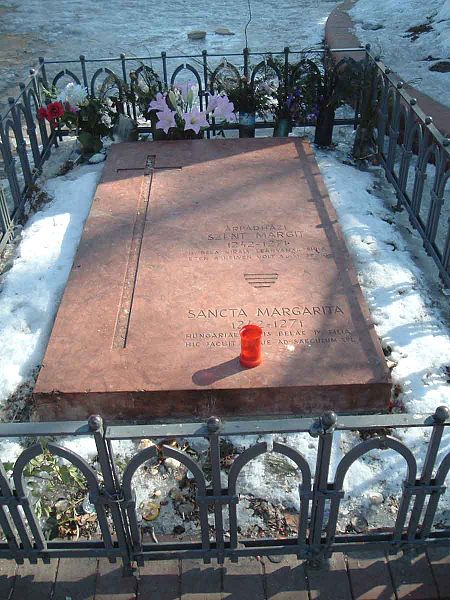Death of Saint Margaret of Hungary. Photo by József Molnár
Daughter of King Bela I of Hungary and his wife Marie Laskaris, born 1242; died 18 Jan., 1271. According to a vow which her parents made when Hungary was liberated from the Tatars that their next child should be dedicated to religion, Margaret, in 1245 entered the Dominican Convent of Veszprem. Invested with the habit at the age of four, she was transferred in her tenth year to the Convent of the Blessed Virgin founded by her parents on the Hasen Insel near Buda, the Margareten Insel near Budapest today, and where the ruins of the convent are still to be seen. Here Margaret passed all her life, which was consecrated to contemplation and penance, and was venerated as a saint during her lifetime.
She strenuously opposed the plans of her father, who for political reasons wished to marry her to King Ottokar II of Bohemia. Margaret appears to have taken solemn vows when she was eighteen. All narratives call special attention to Margaret’s sanctity and her spirit of earthly renunciation. Her whole life was one unbroken chain of devotional exercises and penance. She chastised herself unceasingly from childhood, wore hair garments, and an iron girdle round her waist, as well as shoes spiked with nails; she was frequently scourged, and performed the most menial work in the convent.
Shortly after her death, steps were taken for her canonization, and in 1271-1276 investigations referring to this were taken up; in 1275-1276 the process was introduced, but not completed. Not till 1640 was the process again taken up, and again it was not concluded. Attempts which were made in 1770 by Count Ignatz Batthyanyi were also fruitless; so that the canonization never took place, although Margaret was venerated as a saint shortly after her death; and Pius VI consented on 28 July, 1789, to her veneration as a saint. Pius VII raised her feast day to a festum duplex. The minutes of the proceedings of 1271-1272 record seventy-four miracles; and among those giving testimony were twenty-seven in whose favour the miracles had been wrought. These cases refer to the cure of illnesses, and one case of awakening from death. Margaret’s remains were given to the Poor Clares when the Dominican Order was dissolved; they were first kept in Pozsony and later in Buda. After the order had been suppressed by Joseph II, in 1782, the relics were destroyed in 1789; but some portions are still preserved in Gran, Gyor, Pannonhalma. The feast day of the saint is 18 January. In art she is depicted with a lily and holding a book in her hand.
Saint Margaret’s grave in the Dominican monastery, Margaret Island, Budapest. Her grave site was devastated by the Turks in the sixteenth century.
NEMETHY-FRAKNOI, Arpadhazi b. Margit tortenetehez (Budapest, 1885), being contributions on the history of Blessed Margaret of the House of Arpaden; DEMKO, Arpadhazi b. Margit elete (Budapest, 1895), a life of the saint. Further bibliographical particulars in Arpad and the Arpaden, edited by CSANKI (Budapest, 1908), 387-388; minutes of the proceedings of 1271-72, published in Monumenta Romana Episcopotus Vesprimiensis, I (Budapest, 1896).
A. ALDASY (Catholic Encyclopedia)
[She was canonized 19 November, 1943, by Pope Pius XII]




No comments:
Post a Comment